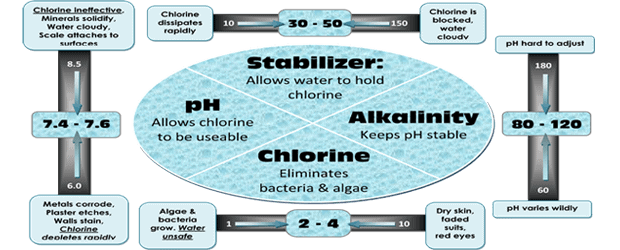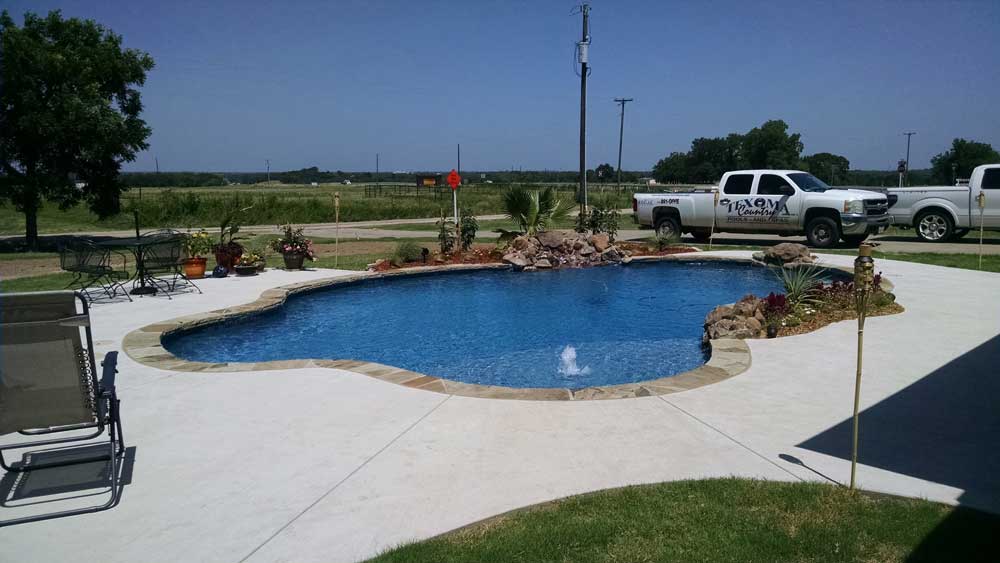A sparkling clean pool doesn’t just happen. There is a method to the beauty behind every pool.
There are a few things you must know about products, parts, care, and how to test your water in order to maintain that dream swimming pool.
Learn more about pool care basics from us directly.
While you’re on the phone, get a look at our pool gallery, or learn more about Texoma Swimming Pools.
Circulation
What Is The Role Of The Swimming Pool Pump?
Like the human body requires circulation, so too does a swimming pool.
Consider the pump as the heart of the swimming pool. It moves water from the pool and sends it through the filter for removal of any dust, dirt, and debris prior to sending it back to the pool.
Think of the circulatory system in the body, sending blood through the kidneys for cleaning, and then back into the circulatory system to be continually pumped throughout the body.
The same goes for the pump, the lines required to complete the circuit, and the filters required for the sanitation and cleaning of the pool water.
How long should I run my swimming pool pump?
Piping size, pool size, swimmer load and the actual pump size all play a role in determining how long you should run your pump.
Call us, so we can learn about your pool specifics in order to give you a more accurate recommendation.
A good rule of thumb is to run your pump about 1 hour for every 10º of temperature.
What Is The Role Of The Filtration System?
Refer to our human body analogy above.
The filtration system in a swimming pool, in essence, are the kidneys of the swimming pool, removing any undissolved dirt and debris from the pool water.
Additional components help remove other debris from the pool such as the skimmer basket. Things to pay attention to.
Backwashing sand or DE filters too often can reduce the efficiency of the filter, by reducing its cleaning capability while increasing water usage.
A good rule of thumb for most filters is to backwash when the pressure gauge rises 8-10 psi from clean.
Always consult a professional and your owner’s manual in order to understand your specific set up and pool needs.
What Are The Common Swimming Pool Filter Types?
There are three types of filters that are used in swimming pools to remove unwanted dirt and debris.
Sand Filters
These filters remove dirt by backwashing or ‘reverse flow”.
General rule of thumb, filters are backwashed when the pressure gauge is 7-10 lbs. higher than normal operating pressure.
Since dirt actually helps catch additional dirt, these filters should only be backwashed when required by the increase in pressure.
Reminder, sand filters should be cleaned at least every season with a filter cleaner.
Cartridge Filters
Similar to a sand filter, a cartridge filter needs to be cleaned when the pressure gauge indicates an increase of 7-10 lbs. over normal operating pressure. Best practice is to have two sets of cartridges, as while one set is removed, hosed off, soaked in filter cleaner (12 hours), removed and rinsed, and then allowed to dry, the other filter can be installed to avoid any down time.
Diatomaceous Earth Filters
The DE filter is cleaned by backwashing the filter when pressure increases 7-10 lbs.
Once the filter has been backwashed, new DE MUST BE added to coat the grids in the filter.
Diatomaceous Earth Filter grids should be cleaned at least once every season using filter cleaner.
Also, at least once a year the entire DE filter should be disassembled and cleaned thoroughly as well as being inspected for tears or rips in the grids.
Pool Care Basics Continued
How Do I Test My Pool?

First off, understand you must test your pool 2-3 times a week during the summer and once a week during the winter.
There is no getting around pool maintenance if you want to maintain a dream-like swimming pool.
This maintenance is preventative and helps you keep on top of water balance, sanitizer levels, and ensures a comfortable swim for swimmers. It’s as easy as 1,2,3.
Test strips test the pool for adequate sanitizer levels as well as pH and total alkalinity. Proper testing also ensures that calcium levels are maintained and that there are no metals present in the pool water.
Additional preventative maintenance and recognition will help you limit and prevent scaling or corrosive action.
What Is A Balanced pH?
pH is the measure of acids to bases in the pool water. The pH of the pool should be tested and adjusted, if necessary, on a weekly basis.
- If the pH of the pool water drifts acidic, corrosion of pool surfaces and equipment can occur.
- If the pH of the pool water drifts too basic, scaling, deposits, and cloudy water can occur.
- At 8.5, chlorine is only about 10% active.
- At 7.0, chlorine is about 73% active.
- If you maintain pH around 7.5, the chlorine will be 50-60% active. Keeping the pH in check will allow you to use the full potential of the chlorine that is already in the pool.
To lower the pH of the pool, use a pH decreaser.
Want a more complete analysis? Visit us in-store.
Calcium Hardness
Calcium Hardness is the amount of dissolved calcium in the pool water.
Low calcium hardness levels can cause plaster to finish etching and shorten the life of vinyl liners.
High calcium levels can result in calcium deposits on the pool surfaces as well as equipment.
The proper range for calcium hardness in pool water is 200- 250 ppm (parts per million) for concrete pools and 175-225 ppm for vinyl pools.
Total Alkalinity
To prevent the pH rollercoaster, maintain the proper amount of acid buffers, or total alkalinity.
Test the pool weekly with a total alkalinity of 1 20-150 ppm (parts per million) maintained.
- Low total alkalinity can result in pH bounce, pH fluctuation, and an increase in corrosiveness and staining.
- High total alkalinity can cause the pH to fluctuate, a cloudy pool and scaling.
Metals
No metals are to be present in swimming pool water.
Metals are a reason for stains and discoloration. The most common metals found in pools are copper, iron, and manganese.
When metals are present, consult a professional for advice, but a rule of thumb is to regularly use a stain and scale remover while determining the source of the metal.
Sanitize with Chlorine
Stabilized chlorine products sanitize your pool water and kill bacteria.
Sanitize with Bromine
You may want to use bromine instead of chlorine to sanitize your pool. Bromine tablets provide a reliable method for killing bacteria and keeping your pool clear and clean.
Shock
Shocking the pool on a regular basis is an important element in keeping the pool clear and clean of such things as algae and cloudy water.
Algaecide
Preventing algae is the key to an enjoyable pool. Algaecides act as a backup to your normal sanitization program and prevent algae from starting and growing in the pool.
Algaecide should be added after every shock treatment.
Always remember consulting a professional and owner’s manual is the best practice as each swimming pool has unique needs.
We will gladly be your swimming pool professionals to take you beyond the Pool Care Basics.





















